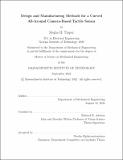Design and Manufacturing Methods for a Curved All-Around Camera-Based Tactile Sensor
Author(s)
Tippur, Megha H.
DownloadThesis PDF (48.46Mb)
Advisor
Adelson, Edward H.
Terms of use
Metadata
Show full item recordAbstract
In recent years, use of camera-based tactile sensors in robotics has grown in popularity as the dexterous and in-hand manipulation tasks we aim to accomplish become more difficult and as the environments a robotic hand must interact with become more complex. Past works have shown that by giving robots the sense of touch, we can greatly improve their ability to complete a variety of sophisticated tasks effectively and efficiently. However, many tactile sensors capable of producing accurate contact localizations, force readings, or 3D reconstructions of the sensor’s surface have a flat 2D shape; this may not be an ideal configuration for robots working in a 3D world. In this work, we present three design and manufacturing methods that were explored to build a curved, all-around, camera-based tactile sensor capable of producing accurate surface deformation depth maps and contact localizations. Additionally, we build off previous GelSight sensors’ photometric stereo lighting methods to develop an orthogonal, cross-shaped illumination structure that has the potential to be transferred to different curved sensor geometries (with some changes to the lighting and camera parameters required). By providing roboticists with an all-around tactile sensor which can be configured to fit specialized tasks on different types of robotic hands, we hope to help reduce some of the constraints considered when approaching a manipulation problem.
Date issued
2022-09Department
Massachusetts Institute of Technology. Department of Mechanical EngineeringPublisher
Massachusetts Institute of Technology